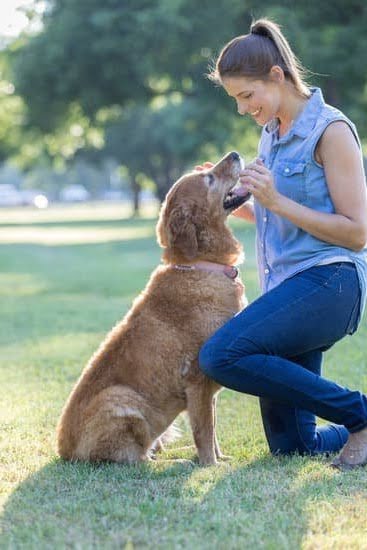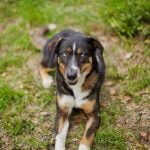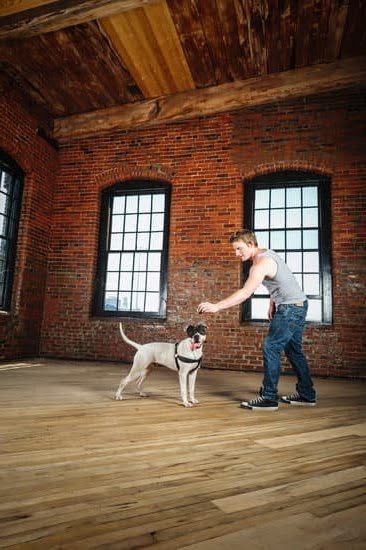Teaching your furry friend to “look away” on command can be a valuable tool for managing their behavior. Understanding the look away command is essential for effective training. This article will delve into the benefits of teaching your dog to look away, how to start training them, tips for reinforcing this command, common mistakes to avoid, troubleshooting if your dog is struggling, and advanced training techniques.
The look away command can be particularly useful in situations where you want your dog to redirect their attention from something that may be causing them anxiety or excitement. It can also help prevent unwanted behavior, such as jumping on guests or begging for food at the dinner table. By mastering this command, you can improve communication with your pet and strengthen your bond.
To begin training your dog to look away, it’s important to start with a solid understanding of how dogs interpret and respond to visual cues. This will set the foundation for successful training and ensure that you are effectively communicating with your pet. With consistent practice and positive reinforcement, you can gradually teach your dog to look away on command in various scenarios.
Training your dog to look away may require patience and persistence, but the benefits are well worth the effort. By incorporating this command into everyday situations and using advanced training techniques when necessary, you can help your dog become more attentive and responsive while strengthening your relationship with them.
The Benefits of Teaching Your Dog to Look Away
Teaching your dog the “look away” command can have numerous benefits for both you and your furry friend. By mastering this skill, your dog can learn to focus their attention away from distractions, which can be incredibly useful in various situations.
The benefits of teaching your dog to look away include:
- Improved focus: Teaching your dog to look away can help them develop better focus and self-control, making it easier for them to ignore distractions and follow your commands.
- Reduced stress: For some dogs, certain people or other animals may trigger anxiety or stress. By training your dog to look away, you can help them avoid potential triggers and stay calm in these situations.
- Enhanced safety: In some situations, a simple “look away” command could prevent your dog from approaching a potentially dangerous situation, such as a busy street or aggressive animal.
To start training your dog to look away, you can begin with simple exercises at home. Here are some steps to get started:
- Choose a quiet environment with minimal distractions.
- Hold a treat in your hand and allow your dog to see it.
- Say “look away” and then move the treat slightly to the side of their face.
- As soon as they turn their head in the opposite direction, reward them with the treat and praise.
By consistently practicing and reinforcing the “look away” command, you can help your dog develop this important skill and enjoy its many benefits. Remember to be patient and consistent with the training process, as every dog learns at their own pace.
How to Start Training Your Dog to Look Away
Training your dog to look away can be a useful command in various situations, such as when they are begging for food or becoming fixated on something. Teaching your dog the “look away” command can help in managing their behavior and preventing unwanted actions.
Establish a Reward System
Start by establishing a reward system using treats that your dog loves. Have a handful of small, bite-sized treats with you before beginning the training session. This will serve as positive reinforcement for your dog when they successfully execute the “look away” command.
Practice in a Quiet Environment
Choose a quiet and familiar environment to begin the training process. Eliminate any distractions that may hinder your dog from focusing on the training. It is essential for your dog to be able to concentrate on you during this training session, so pick a location where they feel comfortable and at ease.
Use Hand Gestures and Verbal Cues
Once you have established the reward system and chosen the right environment, it is time to introduce hand gestures and verbal cues. Start by getting your dog’s attention with a treat in one hand while using your other hand to gesture them to look away from the treat. Simultaneously say “look away” or any other verbal cue you choose to associate with this action. With consistent practice, your dog will start associating these cues with the desired behavior.
By following these steps and incorporating consistent practice, you can effectively start training your dog to look away on command. Remember that patience and persistence are key in ensuring that your furry friend masters this essential skill.
Tips for Reinforcing the Look Away Command
Now that you have begun training your dog to look away, it is important to reinforce this command in order to ensure its effectiveness. By consistently reinforcing the look away command, you can help your dog develop the discipline needed to obey this instruction even in distracting situations. Here are some tips for reinforcing the look away command:
- Consistency is key: It is essential to be consistent with your commands and rewards when reinforcing the look away behavior. Use the same verbal cue and hand signal each time, and make sure to reward your dog immediately when they successfully look away.
- Gradually increase distractions: Once your dog has mastered looking away in a controlled environment, gradually introduce more distractions. This will help them learn to focus even when there are other tempting stimuli present.
- Use positive reinforcement: Positive reinforcement techniques such as treats, praise, or playtime can be effective tools for reinforcing the look away command. Celebrate and reward your dog’s obedience every time they respond correctly.
By implementing these tips, you can strengthen your dog’s understanding of the look away command and improve their ability to follow this instruction consistently. Remember that patience and consistency are crucial when reinforcing any type of training with your dog.
Common Mistakes to Avoid When Training Your Dog to Look Away
When training your dog to look away, it’s important to be aware of some common mistakes that can hinder the effectiveness of your training efforts. By avoiding these pitfalls, you can ensure that your dog learns the look away command successfully.
Being Inconsistent
One of the most common mistakes pet owners make when training their dogs is being inconsistent with the command. If you’re not consistent with the look away command, your dog may become confused and take longer to learn the behavior. Make sure that everyone in the household is using the same cues and hand signals when giving the command so that your dog doesn’t get mixed signals.
Using Punishment
Using punishment or negative reinforcement when training your dog to look away can be counterproductive. Instead of instilling a positive association with the behavior, it can lead to anxiety and stress. This can ultimately make it more difficult for your dog to learn and perform the command.
Skipping Basic Training Steps
Another mistake to avoid is skipping basic training steps when teaching your dog to look away. It’s important to start with basic obedience training before moving on to advanced commands like “look away.” Without a solid foundation in obedience, trying to train your dog for more complex commands may result in frustration for both you and your pet.
By being mindful of these common mistakes and taking proactive measures to avoid them, you can set yourself up for success when teaching your dog to look away. Remember that patience, consistency, and positive reinforcement are key components of effective training-so stay committed and enjoy watching as your furry friend learns this valuable skill.
Troubleshooting
Training your dog to look away on command can be a challenging process, and it’s not uncommon for some dogs to struggle with this skill. If you find that your dog is having difficulty with the “look away” command, there are a few things you can do to help them overcome these challenges.
First, it’s important to assess whether your dog understands the command itself. Some dogs may simply not understand what “look away” means, so it’s crucial to go back to basics and reinforce the command from the beginning. Use high-value treats or toys to get your dog’s attention and then give the “look away” command while gently turning their head in the desired direction.
If your dog still seems confused or is resisting the training, it might be helpful to break down the training sessions into shorter, more frequent intervals. This will prevent your dog from becoming overwhelmed and help them retain what they’ve learned. Additionally, make sure that you’re providing plenty of positive reinforcement when your dog does respond correctly to the command.
In some cases, seeking professional help from a certified dog trainer or behaviorist can also be beneficial if your dog continues to struggle with the “look away” command despite repeated training attempts. They can provide personalized guidance and advice based on your dog’s specific needs and temperament. Remember that every dog is different, and patience is key when it comes to training them effectively.
| Troubleshooting Tips | Benefits |
|---|---|
| Assess if Dog Understands Command | Improves Communication Between You & Your Dog |
| Shorter Training Intervals | Reduces Stress for Your Dog During Training |
| Seek Professional Help If Needed | Personalized Guidance Based on Dog’s Needs |
Incorporating the Look Away Command Into Everyday Situations
Once your dog has mastered the “Look Away” command, it’s time to start incorporating it into everyday situations. This command can be very useful in various scenarios, such as when you want your dog to avoid eye contact with other dogs or strangers, when you want to redirect their attention from something they shouldn’t be focusing on, or simply when you want to communicate that the current behavior is unwanted.
One common situation where the “Look Away” command can come in handy is during walks. If you notice your dog getting too fixated on something, whether it’s another dog, a squirrel, or a passing car, using the “Look Away” command can redirect their attention back to you. This not only helps in maintaining control during walks but also reinforces the training by applying it in real-life situations.
Another everyday situation where the “Look Away” command is useful is during feeding time. Many dogs tend to stare at their owners while they’re preparing or eating food, which can be bothersome. By teaching your dog to “look away” on command during these times, you can encourage better manners and prevent begging behavior.
Finally, incorporating the “Look Away” command into greetings with guests at home can also be beneficial. Some dogs may exhibit overly excited or even aggressive behavior when making eye contact with strangers. By using the “Look Away” command in these situations, you can help manage their behavior and make interactions more pleasant for everyone involved.
| Situation | Use of Look Away Command |
|---|---|
| During walks | Redirect attention from distractions |
| During feeding time | Prevent begging behavior |
| Greetings with guests | Manage excited/aggressive behavior |
Advanced Training Techniques for Mastering the Look Away Command
In conclusion, mastering the “Look Away” command can greatly benefit both you and your dog. Not only does it provide a way to redirect their attention in distracting situations, but it also strengthens your bond and communication with your furry friend. By incorporating advanced training techniques into your practice, you can take the “Look Away” command to the next level and ensure that your dog responds reliably in any situation.
As you continue to work on this command with your dog, remember to be patient and consistent. Advanced training techniques may take some time for your dog to grasp, so be sure to celebrate small victories and progress along the way. Positive reinforcement is key, so continue to use treats, praise, and play as rewards for their successful “Look Away” responses.
Additionally, don’t be afraid to seek professional help if you are facing challenges with advanced training techniques for the “Look Away” command. A certified dog trainer or behaviorist can provide personalized guidance and support to address any hurdles you may encounter. With dedication and perseverance, both you and your dog can successfully master the “Look Away” command and enjoy the many benefits it brings.
Frequently Asked Questions
How Do I Teach My Dog to Go Away?
One way to teach your dog to go away is by using positive reinforcement. Start by teaching your dog a “go to your bed” or “go to your mat” command and reward them when they follow the command.
Gradually increase the distance and duration that your dog needs to stay in their designated spot before receiving a reward. Consistency and patience are key in teaching this behavior.
How Do You Teach the Look Command?
Teaching the “look” command can be done by holding a treat near your eyes and saying “look.” When your dog makes eye contact, reward them with the treat and praise. Gradually increase the duration of eye contact before giving the treat. With consistent practice, your dog will learn to associate the word “look” with making eye contact with you.
How Do I Get My Dog to Keep Eye Contact?
To get your dog to keep eye contact, start by holding a treat near your face and saying “watch me.” When your dog makes eye contact, reward them with the treat and praise.
Practice this command regularly, gradually increasing the duration of eye contact before giving the treat. It’s important to make it a positive experience for your dog so that they learn to enjoy maintaining eye contact with you.

Welcome to the blog! I am a professional dog trainer and have been working with dogs for many years. In this blog, I will be discussing various topics related to dog training, including tips, tricks, and advice. I hope you find this information helpful and informative. Thanks for reading!





